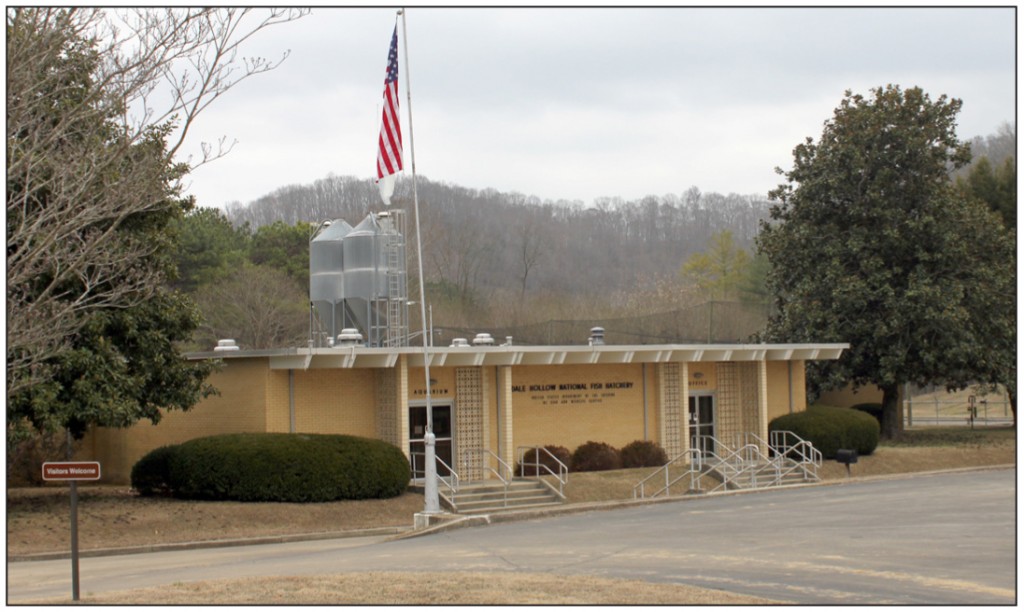TVA agrees to fund trout hatchery operations for the next three years

IN AGREEMENT-U.S. Senator Lamar Alexander (standing) joined representatives from TVA, TWRA, US Fish and WIldlife Service, and the Georgia Department of Natural Resources as they signed the new agreement funding the operations of the fish hatchery here and others across the region. (photo courtesy www.news.tn.gov)
CELINA-The Tennessee Wildlife Resources Agency (TWRA) Nashville office was the site for a news conference where U.S. Sen. Lamar Alexander, and officials from the Tennessee Valley Authority (TVA), U.S. Fish & Wildlife Service, TWRA, and the Georgia Department of Natural Resources announced a new agreement Friday to continue popular trout stocking programs in the Tennessee Valley region–which means operations here at the Dale Hollow National Fish Hatchery will continue keeping the local facility open.
TVA will provide more than $900,000 per year over the next three years to support federal fish hatchery operations that provide trout for stocking. The stocking will occur in reservoirs and tailwaters of certain TVA dams in the region.
In addition, the agencies also signed an agreement to form a working group with key stakeholders who benefit from the recreation-based trout stocking to identify a long-term funding source.
“The funding of the federal hatchery operations is vital to our agency’s ability to meet the demand for quality trout fishing in Tennessee,” said Ed Carter, TWRA Executive Director. “Their continued operation will help continue providing a tremendous recreational activity to thousands of Tennesseans. An associated but very important side benefit is the significant economic boost to local businesses associated with the fishing and outdoor industry.”
Currently, non-native trout stocked near some of TVA’s dams are raised at three federal fish hatcheries operated by the U.S. Fish & Wildlife Service: Erwin National Fish Hatchery in Erwin, TN; Chattahoochee Forest National Fish Hatchery in Suches, GA, and the one here.
“Closing Dale Hollow and Erwin would have been a disaster for 900,000 Tennesseans and visitors who bought fishing licenses last year,” Alexander said. “Dale Hollow helps make Tennessee’s rivers and lakes among the most prized trout fisheries in our country. And the Erwin hatchery provides brood stocks for fishing waters across the country.”
The trout are provided to the TWRA and Georgia Department of Natural Resources for stocking in the colder water of the reservoirs and tailwaters of the TVA dams. TVA supports the stocking programs by enhancing aquatic habitat through oxygenation systems, foregoing electric generation and providing minimum river flows to help adequately maintain cooler water temperatures. However, in most of the waters, the trout cannot naturally reproduce, requiring regular stocking to maintain fishable populations.
“TVA is voluntarily providing three years of stewardship funding for trout hatchery operations because the agencies involved understand the importance of stocked trout waters to recreation, tourism and local economies,” said Joe Hoagland, TVA senior vice president of Policy and Oversight. “At the same time, the working group being formed to look at ongoing, sustainable funding is critical given TVA’s focus on keeping electric rates low and the budget challenges of all the participating agencies.”
“The U.S. Fish and Wildlife Service greatly appreciates TVA’s dedicated funding for the next three years,” said Cindy Dohner, the U.S. Fish and Wildlife Service’s regional director for the Southeast. “We also are encouraged by the commitment by all the agencies to develop a long-term, sustainable funding source for this important conservation, recreational, and economic activity for our citizens.”
Through this three-year hatchery funding agreement, trout will continue to be stocked for recreational fishing in reservoirs or tailwaters at 12 TVA dams in Tennessee and Georgia: Apalachia Dam on the Hiwassee River; Blue Ridge Dam on the Toccoa River; Cherokee Dam on the Holston River; Ft. Patrick Henry Dam on the South Fork Holston River; Normandy Dam on the Duck River; Norris Dam on the Clinch River; Ocoee Dam No. 1 on the Ocoee River; South Holston Dam on the South Fork Holston River; Tellico Dam on the Little Tennessee River; Tims Ford Dam on the Elk River; Watauga Dam on the Watauga River; and Wilbur Dam on the Watauga River.
“The Blue Ridge Dam-Toccoa River project is a critical trout fishery for our citizens and the economy of the area,” said Dan Forster, director of the Wildlife Resources Division for the Georgia Department of Natural Resources. “This agreement provides an important step in addressing the long-term continuation of trout production and stocking associated with this fishery.”
Details on the trout hatchery funding working group are currently being developed. The agencies will be seeking representation, ideas and input from angling groups, local and regional businesses, tourism organizations and the local governments that realize the direct and indirect benefits of having fishable trout waters in their communities.
“This is good news for Tennessee fishermen,” Alexander said of the hatchery agreement. “TVA has helped make sure Tennessee’s rivers and lakes will remain among the most prized trout fisheries in our country.”

